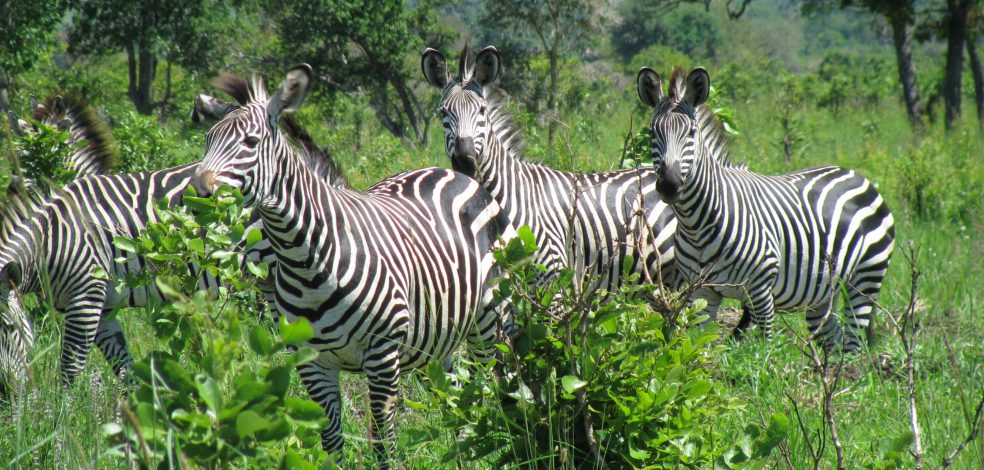In the book of Exodus, Yahweh inflicts upon the Egyptians ten plagues, several of which have biological bases. Plagues two three, four and five are frogs, lice, wild animals and diseased livestock. But it is the eighth plague that is relevant to today’s tale – the locust explosion. As it turns out, insect populations have periodically exploded throughout recorded history (and no doubt before), and for many years ecologists have been trying to understand why insect populations are so variable. Rick Karban has taught a field course at Bodega Marine Reserve, California since 1985, and, as he describes “In some years, the bushes are dripping with caterpillars and in others they are very difficult to find. The wooly bears (Platyprepia virginalis) are so conspicuous and charismatic that I couldn’t help wondering what was responsible for their large swings in abundance (they are more than 1,000 times as abundant in big years than in lean ones).”
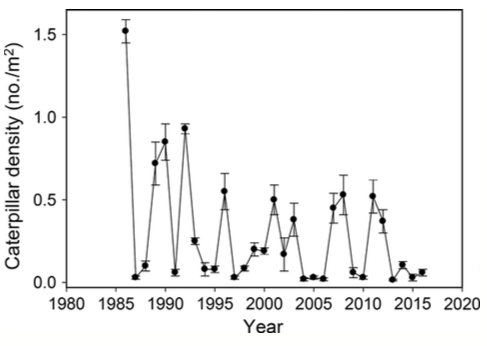
Wooly bear caterpillar density during annual surveys conducted in march of each year.
The early stage caterpillars are most common in wet marshy habitats, but as they develop, they move to dryer upland habitats where they pupate, metamorphose into moths and mate. Young caterpillars live in leaf litter, eating vegetation and decaying organic matter.

Late instar (close to pupation) wooly bear caterpillar feeding on bush lupine. Credit Rick Karban.
Karban and his colleagues recognized that insect populations are sensitive to climate, and wondered whether climate change may be playing a role in Platyprepia population explosions. But there’s much more to climate change than global warming; for example, many areas of the world expect much more variable precipitation patterns, with more big storms and more droughts. Karban and his colleagues wanted to know whether variable precipitation might affect wooly bear populations. So they examined rainfall records between 1983 and 2016, and found that numerous heavy rainfall events (over 5 cm) in the previous year were correlated with increases in caterpillar abundance.
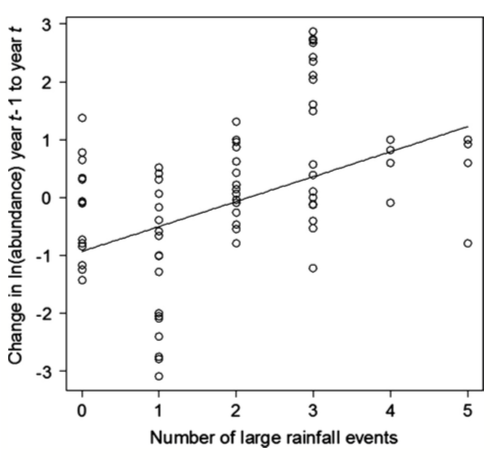
Change in caterpillar abundance in relation to number of heavy rainfall events (over 5 cm) during the previous year. Note the y-axis is the natural logarithm of the change in abundance.
Karban and his students explored three hypotheses for why caterpillars increased following a year with numerous heavy rainfall events. First, perhaps more rain causes more plant growth and deeper litter, providing extra food for caterpillars. Second, heavy rains may reduce the number of predacious ground-nesting ants. Lastly, heavy rains may produce deeper denser litter providing refuge from predacious ants.
The researchers tested litter as food hypothesis by comparing caterpillar growth rates during the summer, which usually has very little rainfall. They weighed individual caterpillars, placed them into cages and supplied them with litter from either wet or dry sites. After 30 days, they reweighed the caterpillars and found that all of them had lost weight, and that there were no significant differences in weight change between wet and dry sites. Thus, at least during the summer, there was no evidence that wet sites had better food for caterpillars.
Karban and his colleagues turned their attention to ants.
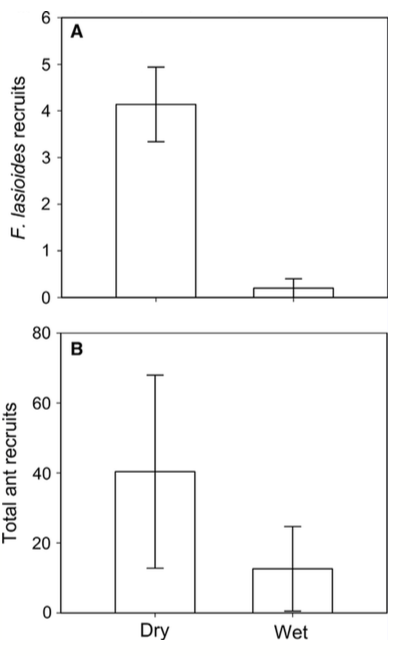
If ants stayed away from wet sites, that would suggest that rainy years may benefit caterpillars by reducing the number of ants in their habitat. To measure ant abundance, the researchers set out bait stations supplied with a sugar-laced cotton ball and 1 cm3 of hot dog. They discovered many more ants, and in particular, many more Formica lasioides (a fearsome caterpillar-killer) ants were recruited to dry sites than wet sites. This suggested that years with numerous rainfall events might reduce ant abundance, at least in the wet areas preferred by young caterpillars.
The researchers tested the ant predation hypotheses by caging caterpillars in plastic deli containers that had either window screen bottoms that allowed ants to enter but prevented the caterpillars from leaving, or had spun polyester bottoms that prevented ant access. At each of 12 field sites, the caterpillars were caged with litter that matched the depth and wetness of litter found at that site. All caterpillars protected from ants survived, while 40% of the unprotected caterpillars from dry sites and 23% of the unprotected caterpillars from wet sites were killed by predators. So ants are clearly fearsome predators, but more so under dry conditions.

A Formica lasioides ant subdues an early install wooly bear caterpillar within the confines of a deli box. Credit Rick Karban.
But does litter wetness help protect against predacious ants? To investigate this question, the researchers placed caterpillars in deli containers that permitted ant access. At each site, two containers were placed side-by-side; one contained a caterpillar + litter from a wet site, while the other contained a caterpillar + litter from a dry site. Both containers were completely filled with litter and left in the field for 48 hours. The researchers discovered that caterpillars were 26% more likely to avoid predation if they were in a container stuffed with litter from a wet site. This suggests that litter from wet sites acts as a refuge for caterpillars against predators.
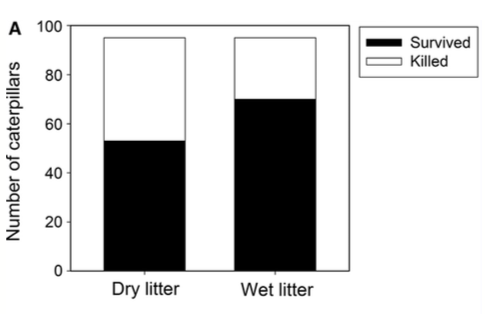
Caterpillar survival rate in relation to litter wetness.
Unfortunately, no long-term data on ant abundance are available, so we don’t know the relationship between ant and caterpillar abundance over time. But when ants were excluded, caterpillars survived well, and when ants were present, caterpillars survived best in wet sites with deep litter. It is not clear why caterpillars survive ant predation better in wet litter. One possibility is that caterpillars are more active than ants at cooler temperatures, and may be more likely to avoid them in wet and cool conditions. A second possibility is that dry litter is structurally less complex than wet litter, and ants may be more likely to move efficiently to capture caterpillars in dry terrain.
Given the predictions for more rainfall variability in coming years, Karban and his colleagues expect caterpillar abundance to fluctuate even more dramatically from year to year. In this system, and presumably other insect populations as well, multiple factors interact to determine whether there will be a population outbreak reminiscent of Pharaoh’s experience early in recorded history.
note: the paper that describes this research is from the journal Ecology. The reference is Karban, Richard, Grof-Tisza, Patrick, and Holyoak, Marcel (2017), Wet years have more caterpillars: interacting roles of plant litter and predation by ants. Ecology, 98: 2370–2378. doi:10.1002/ecy.1917. Thanks to the Ecological Society of America for allowing me to use figures from the paper. Copyright © 2017 by the Ecological Society of America. All rights reserved.
